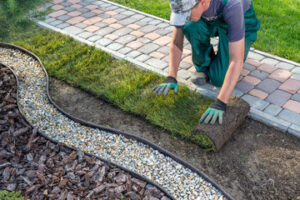Decks Charleston SC is a beautiful addition to any home and offers an outdoor space for relaxing or entertaining. Decks are also a way to make your yard more usable.
Many homeowners want room to entertain, so a deck can provide a gathering place for family and friends. Decks can feature dining tables, a grill, and fire pits.

Unlike a patio, a deck is elevated from the ground and often attached to a house. It offers a great way to enjoy a view or expand living space outdoors. Typically constructed from wood, composite materials or a combination of both, a deck can be designed to include a number of amenities to enhance functionality and increase enjoyment.
Creating an effective deck can be a challenge, but it’s worth taking the time to learn from others and practice. For example, you could read through decks of renowned designers and try to understand their structure, organization and storytelling techniques. It’s also worth seeking out feedback from colleagues and incorporating constructive criticism into your own work.
Decks are commonly used for business pitches and presentations, but can also be a useful tool to communicate ideas or showcase a portfolio of your creative work. As such, a good deck should be both compelling and accessible to your audience. It should be clear and concise, with a structured layout that allows the viewer to follow your train of thought. It should also use visual elements, such as graphs and images, strategically to reinforce your message or make complex information easier to understand.
A good deck should include a summary page, which gives an overview of the main points of your presentation. This should be followed by a list of your key projects or skillsets, with examples to illustrate. You should also include a contact page to let people know how to get in touch with you.
For more details about how to create a great deck, see our guide to crafting an impressive portfolio. A lot of the same tips apply to creating a successful deck, but you should also tailor your approach to suit the purpose of your presentation or pitch. For instance, a deck for a client pitch will require a different style to one for a team catch-up.
When it comes to designing your deck, be sure to choose durable, low-maintenance materials. A well-constructed deck should be comfortable to walk on, with surfaces that are smooth and splinter-free. You can also add comfort-enhancing features like a built-in bar, barbecue area or outdoor lighting to extend your deck’s usability into the evening.
Materials
A deck is a flat platform that can be used as a spot to relax with a drink after work, host an al fresco dinner party or watch the sunset. Depending on the materials used, it can also provide a sturdy surface to stand on when exercising or playing outdoor games. When planning your own deck, the material you choose is a major consideration, as it determines how much maintenance and repair will be needed.
Wood is the most common material for decks, and it’s available in a variety of species and styles. The most popular type is pressure treated pine, which undergoes a chemical treatment to make it resistant to rot and mold. A protective sealant is often applied to the surface as well. Pressure-treated wood is less expensive than other types of lumber and can last for years without deteriorating.
Hardwoods are also popular for decks, and include cedar, redwood and ipe. However, commercial logging of these woods is a major cause of environmental concerns, especially as they’re harvested from tropical forests. If you choose to use hardwoods, be sure to purchase certified sustainable wood products.
Composites are an alternative to traditional wood and come in a variety of natural-looking hues and grain patterns. They’re made from a blend of recycled plastic and waste wood fibers, and their surface doesn’t splinter. Composites are heavier than most woods and require regular scrubbing to prevent mildew growth, but they offer the advantage of lasting longer than traditional wood.
Another option is concrete, which can be poured onto a frame to form a raised walkway. This is typically a good choice for ground-level decks and can be shaped and colored to match your home’s exterior. Concrete is heavy, though, and may require additional structural support to prevent sagging over time. It’s also not a good choice for elevated decks, as it can shift and crack under stress. To avoid moisture damage, a flashing system is often used between the ledger board and your home to channel water away from the deck.
Structural Considerations
Decks are a popular feature that can enhance a home’s outdoor living space and provide a place to entertain or relax. However, if not constructed properly, decks can be unsafe and even fail completely. With the number of deck collapses rising, building codes are beginning to specify minimum standards for deck construction. It is therefore essential to consult a structural engineer when planning and constructing a new deck to ensure that all applicable requirements are met.
The anatomy of a deck begins with footings, which are concrete pillars that spread the load of the deck over a larger area. They are poured into holes that you dig in the ground, and in cold climates they may need to be below the frost line to avoid shifting of the concrete during freezing and thawing cycles.
Joists, the main beams of a deck, are attached to the footings and span the width of the deck. To keep them from twisting or buckling under the load, you will need to install blocking in a zigzag pattern between joists. This will prevent rot and also ensure that the joists do not pull away from the deck’s foundation over time.
Local building codes and guidelines dictate how high the railings must be on a deck, to protect people from falling off of the structure or becoming injured by the debris that might fall on them. It is also important to consider the spacing of the balusters or pickets in the railing to minimise climbing hazards for children and pets.
Another essential consideration for a safe deck is the stability of its stairs. Stairs are one of the most common areas for accidents, and it is essential to maintain a consistent riser height and tread depth to reduce tripping hazards. Local regulations also dictate the minimum number of handrails and guardrails required on a deck, as well as how they must be constructed to prevent falling or getting stuck.
In some cases, a town will require that the design of a deck is done by a qualified structural engineer prior to granting a permit for its construction. This is because decks can be a significant load bearing part of a house, and if improperly built or maintained, can cause damage to the home.
Maintenance
The addition of a deck to a home provides homeowners with an attractive outdoor living space that can be used for relaxing, entertaining guests, cooking, dining, and working. A well-maintained deck will add beauty and value to the property, but it also requires year-round attention to keep it structurally sound and in good condition.
Wood and composite decks can be damaged by mold, rot, and insect infestation. Proper maintenance can help prevent these problems, keeping the deck in good condition for as long as possible and minimizing repair costs.
Using a soft brush and mild cleaner, clean the surface of the deck regularly to remove dirt, mildew, and debris. Staining the deck with a semi-transparent stain is also recommended, which helps protect the surface from moisture and other contaminants. It’s important to address stains promptly to avoid permanent discoloration of the decking materials. Deck covers are also available for protecting the material from the elements and allowing the owner to customize the color of the decking.
Regular inspections can catch problems before they become serious, saving the deck from costly repairs and extending its lifespan. A basic inspection should include:
Examine the structural boards. Listen for squeaks and feel for soft spots or sagging areas. Search for cracked or rotting boards and protruding nails. Replace any that are found. Check the metal flashing (a water barrier) where the deck connects to your house, and replace it if it is damaged.
Check all handrails and stairs for loose or rotting posts, rails, and steps. Secure any that are loose and replace any that are damaged or rotting. Make sure to check the stair stringers (the saw-tooth notched pieces that support the stairs) for signs of rot. Examine the railings for loose or rusted screws and anchors, and tighten or replace any that are loose or rusty. Ensure that all handrails are secure and safe to use, especially after heavy snow or rain storms. Lastly, sweep the deck of leaves, debris, salt, and other items that can trap moisture, causing mold, mildew, and rot.

